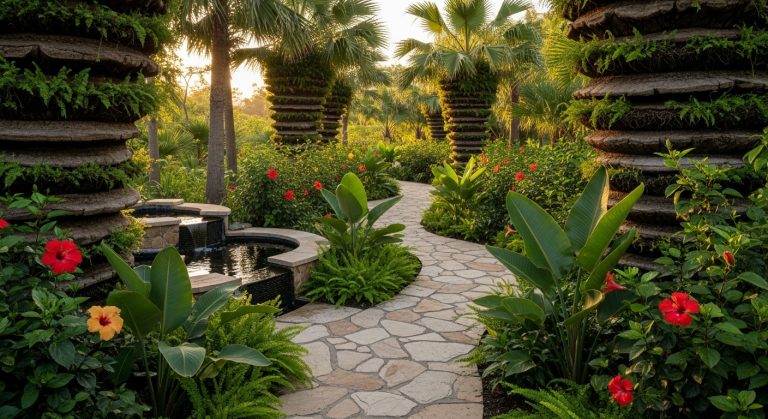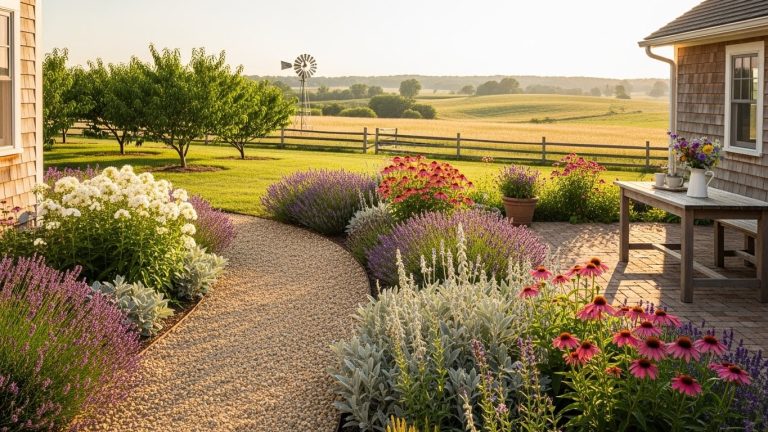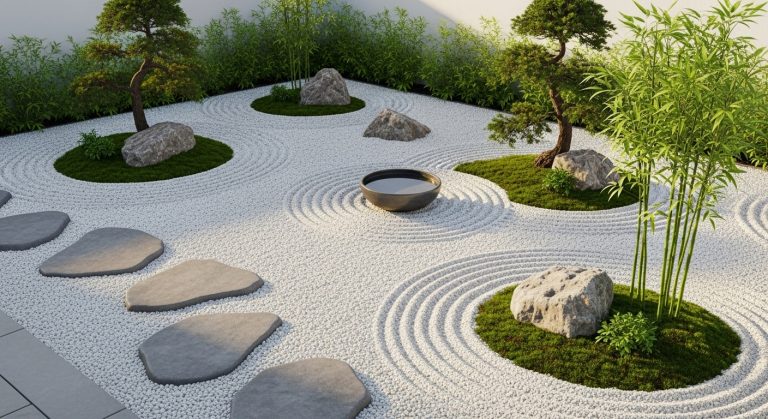15 Hibiscus Garden Ideas That Bring Color and Calm to Your Yard
Ever noticed how a single bright bloom can completely lift your mood? That’s the magic of hibiscus. I remember walking past a neighbor’s yard once, and the fiery red hibiscus bush was impossible to ignore. Instantly, it made the whole street feel warmer. That’s why hibiscus gardens are so captivating — they combine bold color, simple care, and an instant tropical vibe, even in a suburban backyard.
What excites me most about hibiscus is how versatile they are. You can tuck them into small pots on a balcony, line a pathway with them, or dedicate a whole section of your garden. They bring life to spaces that might otherwise feel flat, and honestly, seeing them bloom is addictive. If you’ve been thinking about upgrading your garden, hibiscus is one of the easiest ways to create a lush, happy corner that also looks professionally designed.
Below, I’ve gathered 15 practical, real-world hibiscus garden ideas. Each one includes what I love about it, the small challenges to keep in mind, and a little takeaway you can act on immediately.
1. Classic Backyard Hibiscus Hedge

There’s something so timeless about a row of hibiscus bushes lining your backyard fence. They create privacy, add color, and feel effortlessly elegant without requiring complicated design skills.
Pros
- Privacy and structure — instantly blocks sightlines from neighbors.
- Continuous blooms during peak season create a vibrant wall.
- Low effort once established; minimal pruning keeps shape.
Cons
- Requires space — not ideal for narrow yards.
- Some varieties grow tall and may need seasonal trimming.
Takeaway: A hibiscus hedge is simple, effective, and transforms ordinary fences into focal points.
2. Container Hibiscus on a Patio

Limited space? No problem. Hibiscus plants thrive in large pots, making them perfect for patios or balconies. Bonus: You can move them to chase sunlight or protect them from harsh weather.
Pros
- Portable — move for sun, shade, or seasonal protection.
- Adds a tropical feel even in small spaces.
- Containers can double as decorative elements.
Cons
- Requires more frequent watering than in-ground plants.
- Container size can limit plant growth.
Takeaway: A potted hibiscus is ideal for renters or anyone wanting instant patio color.
3. Hibiscus Borders Along Pathways

Framing a walkway with hibiscus bushes or dwarf varieties can completely change your garden’s first impression. Imagine walking down a path flanked by coral, pink, or golden blooms — dreamy and welcoming.
Pros
- Creates a structured, inviting walkway.
- Variety in bloom color can add playful contrast.
- Easy to incorporate into existing garden paths.
Cons
- Needs pruning to prevent blocking paths.
- Some varieties can attract bees near walking areas.
Takeaway: A hibiscus-lined path transforms simple landscaping into a visual journey.
4. Tropical Hibiscus Corner Nook
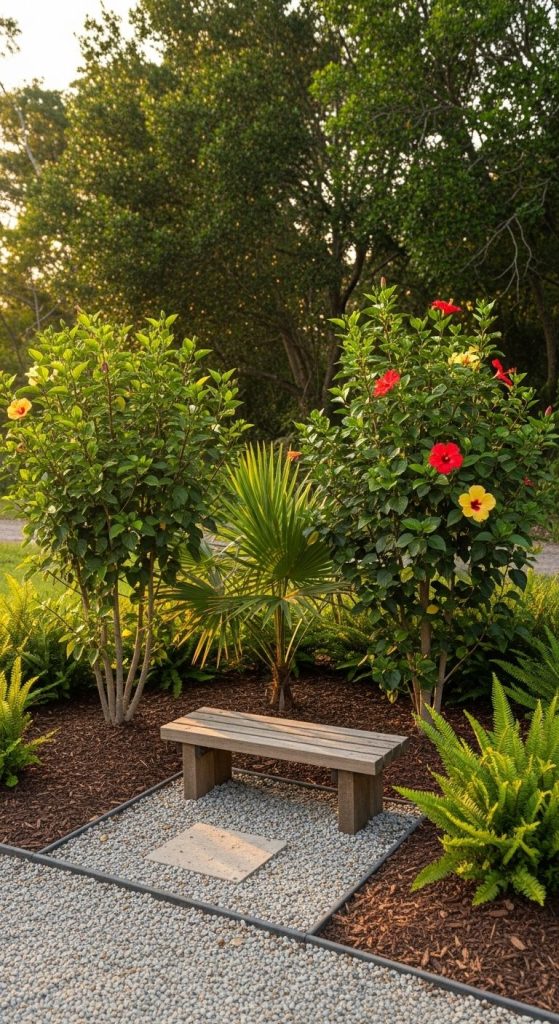
Turn a quiet corner of your garden into a tropical mini-oasis with multiple hibiscus plants, palms, and a small bench. I tried this last summer, and it became my favorite reading spot almost overnight.
Pros
- Immersive tropical vibe — feels like a mini-vacation at home.
- Provides shade and privacy for small seating areas.
- Great for photography or casual entertaining.
Cons
- Requires layering plants carefully for sunlight access.
- Maintenance can be higher due to extra foliage.
Takeaway: Even a small corner can feel like a private retreat with the right hibiscus arrangement.
5. Hibiscus and Butterfly Garden

Hibiscus flowers are excellent for attracting pollinators, making them perfect for a butterfly or hummingbird-friendly garden. I always love watching the action around my bright pink blooms — it’s mesmerizing.
Pros
- Encourages wildlife visits — bees, butterflies, hummingbirds.
- Adds dynamic movement and sensory appeal.
- Pollinators help nearby vegetables or flowers thrive.
Cons
- Some visitors may be unwelcome near food or seating areas.
- Seasonal bloom cycles mean not all plants attract consistently.
Takeaway: Planting hibiscus for pollinators makes your garden alive and interactive.
6. Hibiscus Trellis or Pergola Feature
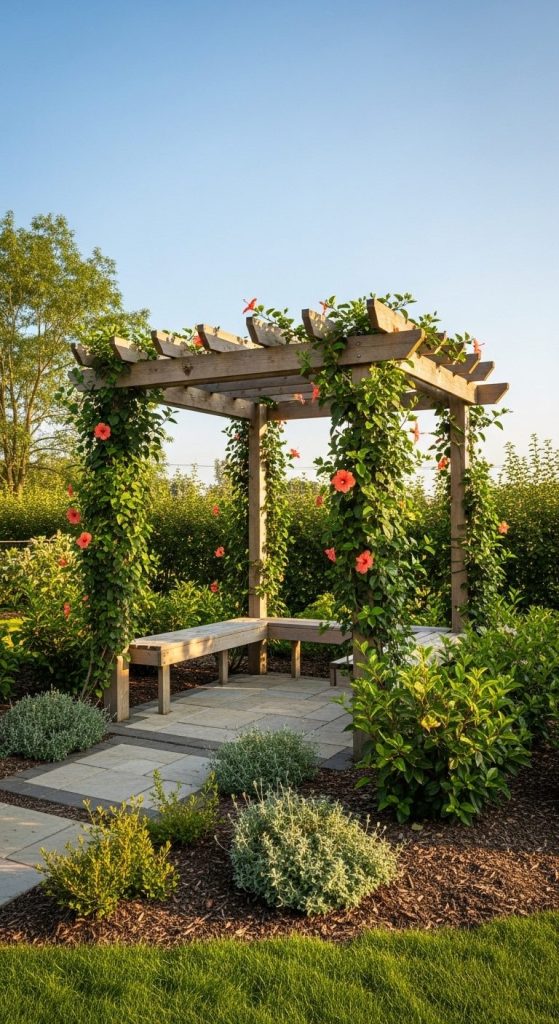
Climbing hibiscus varieties can be trained along a trellis or pergola. This creates a stunning vertical display that adds depth without consuming much ground space.
Pros
- Vertical interest for narrow gardens.
- Can provide shade under pergolas.
- Dramatic, eye-catching focal point.
Cons
- Requires support structure and some training.
- Climbing growth can overwhelm small structures if unmanaged.
Takeaway: A trellis hibiscus display draws the eye upward and creates garden dimension.
7. Hibiscus Mixed Flower Beds

Pair hibiscus with marigolds, salvia, or petunias to create mixed beds with contrasting colors and textures. This gives your garden a fuller, more dynamic appearance instantly.
Pros
- Color variety without cluttered design.
- Can bloom concurrently for continuous visual interest.
- Great for beginners experimenting with plant combinations.
Cons
- Requires consideration of plant height and water needs.
- Some combinations may compete for nutrients.
Takeaway: Mixing hibiscus with compatible annuals creates a lively, Instagram-ready bed.
8. Seasonal Container Displays
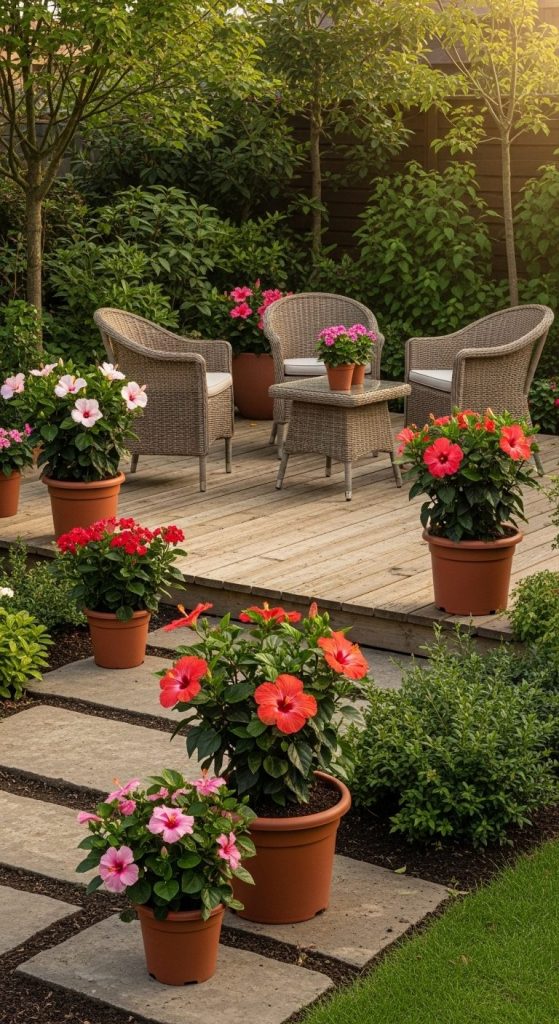
Instead of permanent planting, rotate hibiscus in seasonal containers with complementary flowers and foliage. I did this last spring and my porch looked brand-new every month.
Pros
- Flexible seasonal design — swap plants for fresh looks.
- Easy to protect sensitive plants in winter.
- Perfect for renters or small balconies.
Cons
- Requires regular re-potting and soil changes.
- More frequent watering and fertilizing needed.
Takeaway: Rotating hibiscus in containers keeps your garden dynamic year-round.
9. Tropical Patio Screens with Hibiscus
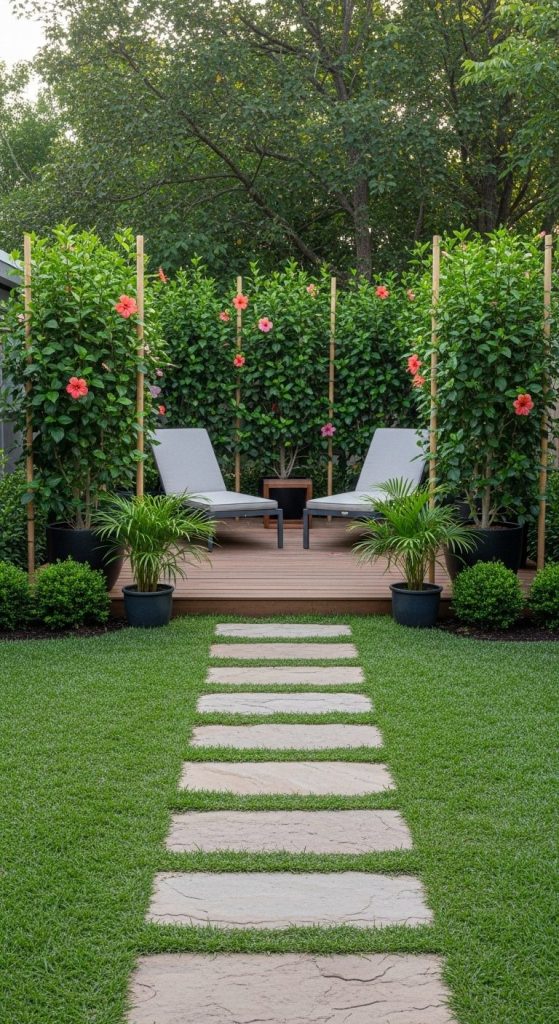
Use taller hibiscus varieties to form natural screens around patios or decks. It’s functional and decorative — much better than standard fences or lattice.
Pros
- Provides privacy without walls.
- Softens hardscape elements like concrete or wood decks.
- Adds seasonal blooms and lush greenery.
Cons
- Growth may require pruning for shape.
- Limited space may restrict taller varieties.
Takeaway: Hibiscus screens are a practical, beautiful alternative to conventional patio barriers.
10. Hibiscus Indoor Sunroom Plants

If you have a sunroom, growing hibiscus indoors can bring summer energy inside. Pink or red blooms brighten neutral interiors instantly.
Pros
- Brightens indoor spaces with natural color.
- Can bloom almost year-round with adequate sunlight.
- Easy to move and reposition for light adjustments.
Cons
- Indoor conditions may require humidity and temperature care.
- Potential mess from fallen petals.
Takeaway: A sunroom hibiscus creates a cheerful, vibrant indoor retreat.
11. Hibiscus Around Water Features
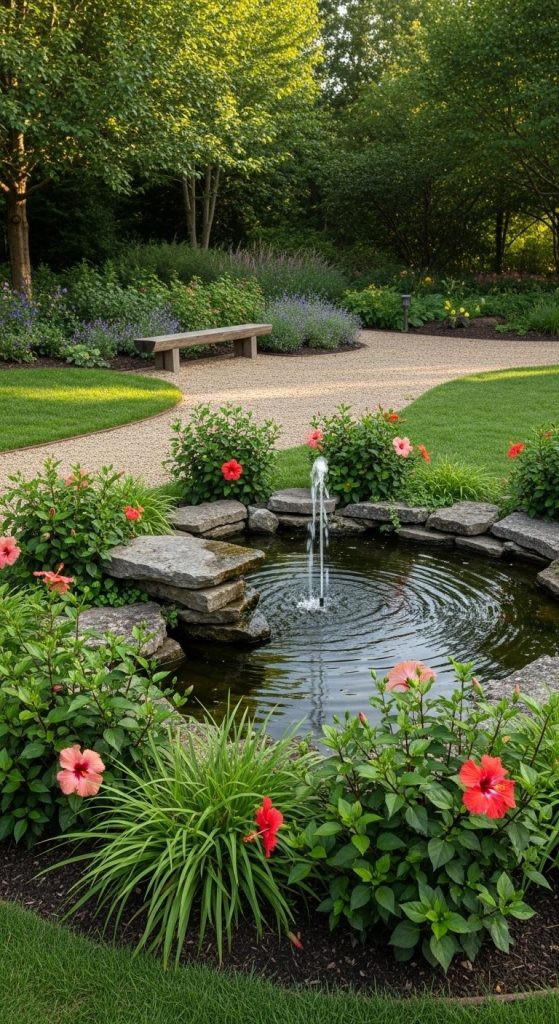
Planting hibiscus near fountains, small ponds, or garden streams complements the reflective water and enhances tropical vibes. The bright blooms contrast beautifully with blues and greens.
Pros
- Enhances visual appeal of water features.
- Creates a resort-like atmosphere.
- Can provide natural shade for small ponds or aquatic plants.
Cons
- Water splashing may damage leaves if overexposed.
- Some varieties prefer well-drained soil away from constant moisture.
Takeaway: Water-adjacent hibiscus plants create serene, picturesque corners.
12. Hibiscus in Rock Gardens
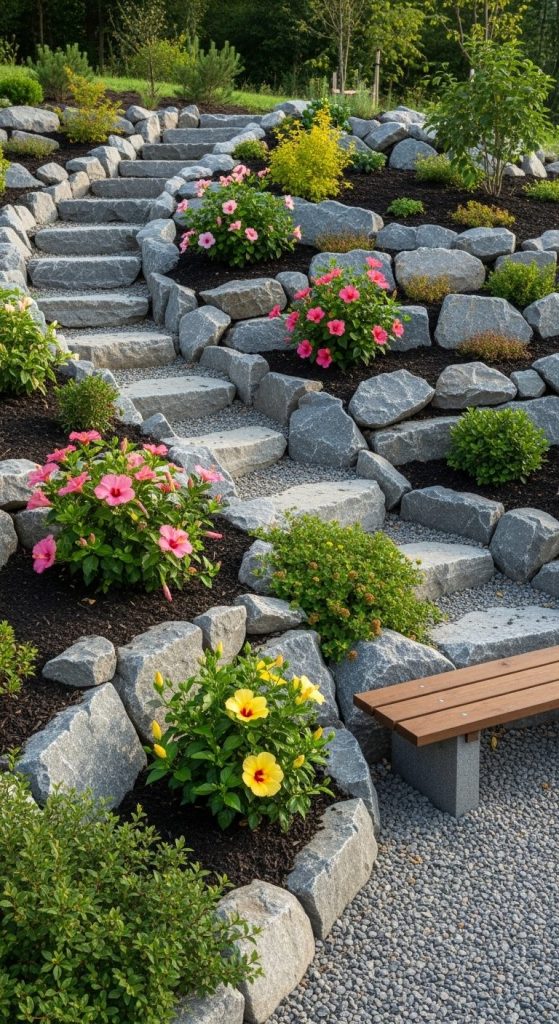
Incorporate dwarf or hardy hibiscus into a rock garden for vibrant pops of color. I was skeptical at first, but the contrast between bright blooms and gray stones is stunning.
Pros
- Color contrast highlights blooms.
- Works in sloped or uneven terrain.
- Low maintenance if hardy varieties are chosen.
Cons
- Soil depth and nutrients may limit growth.
- Rock placement must allow for proper drainage.
Takeaway: Hibiscus in rock gardens creates bold, low-maintenance color highlights.
13. Hibiscus Seasonal Color Rotation
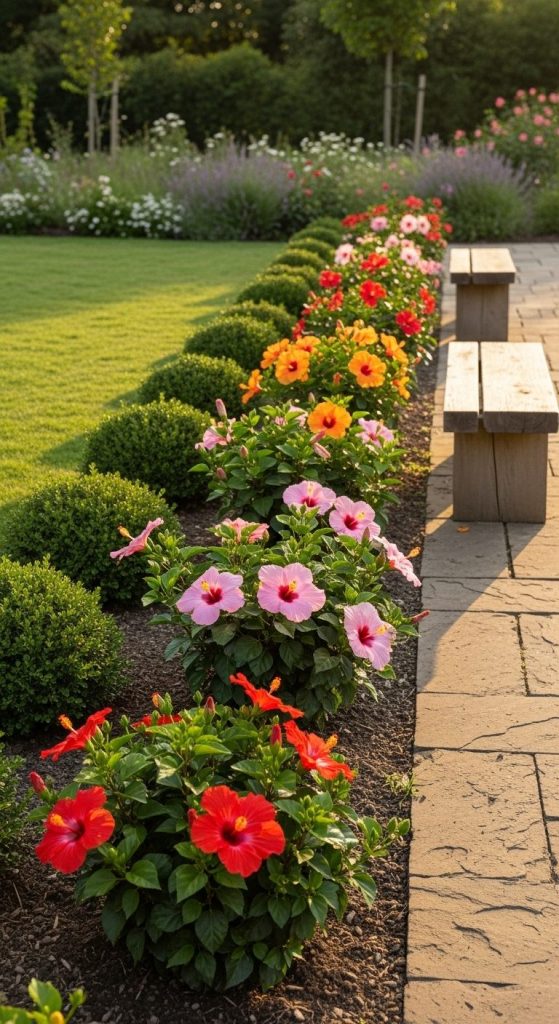
Use multiple varieties to rotate bloom color throughout the year. Early reds, mid-season pinks, and late oranges keep your garden lively and vibrant for longer.
Pros
- Maintains continuous visual interest.
- Provides flexible design options with layering.
- Easy to plan with a small variety mix.
Cons
- Requires careful planning of sunlight and bloom cycles.
- Some varieties may not tolerate repeated pruning.
Takeaway: Color rotation ensures your hibiscus garden never feels static or dull.
14. Hibiscus Accent Against Neutral Backgrounds
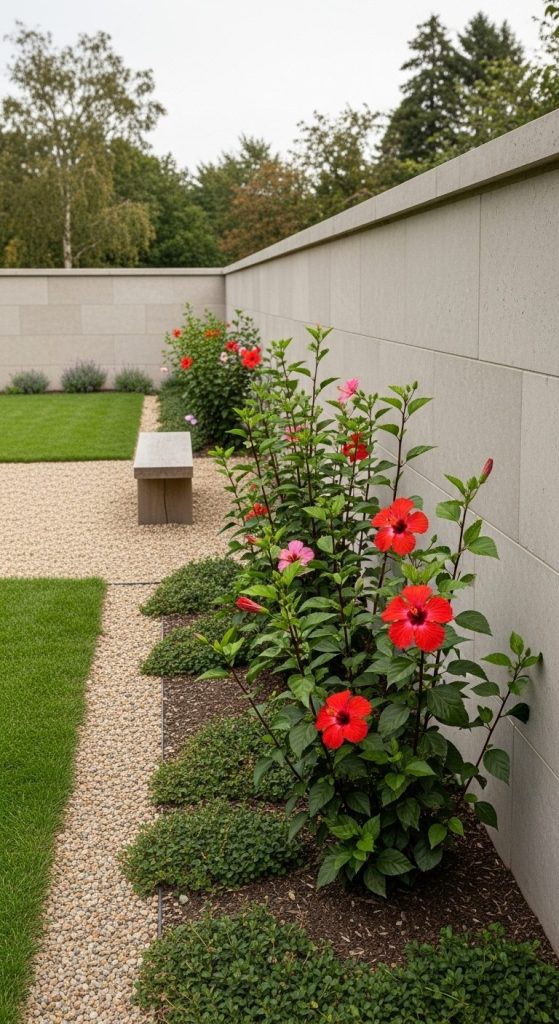
Plant hibiscus near neutral walls, fences, or stone features to make colors pop. The contrast draws the eye and enhances your garden’s depth.
Pros
- Simple way to highlight blooms.
- Works in small or confined gardens.
- Easy to combine with other accent plants or sculptures.
Cons
- Too few plants may make space feel empty.
- Bright colors may require regular pruning to maintain balance.
Takeaway: Using neutral backdrops maximizes hibiscus impact with minimal effort.
15. Hibiscus as Edible or Tea Garden Plant

Some hibiscus varieties produce flowers perfect for teas or garnishes. Integrating them with herbs or vegetables can combine beauty and practicality.
Pros
- Edible blooms add flavor and decoration.
- Supports a multi-functional garden.
- Encourages hands-on garden enjoyment.
Cons
- Requires careful selection of edible varieties.
- Harvesting may reduce visual fullness.
Takeaway: A hibiscus garden can be both beautiful and useful for culinary or tea purposes.
Conclusion
Hibiscus gardens aren’t just colorful—they’re transformative. Whether you line a fence, fill containers, or create a tropical nook, the vibrant blooms and lush foliage instantly elevate your space. I love how adaptable they are, fitting small patios or full backyards with equal charm. Each idea above is achievable, visually appealing, and emotionally rewarding — a little garden therapy in real life.
Personally, I’ve found that the combination of bright hibiscus blooms with layered greenery makes any garden feel alive. Even one or two plants in containers can lift your patio or sunroom, proving that you don’t need acres to enjoy tropical charm. Try one idea first, see how it blooms in your space, and let your garden grow naturally from there.

Ashley Ellison is a skilled writer and avid bowler. Her passion for storytelling and dedication to the sport have led her to participate in various national bowling leagues. With a unique combination of talents, Ashley approaches every challenge with creativity and a relentless drive to succeed.

